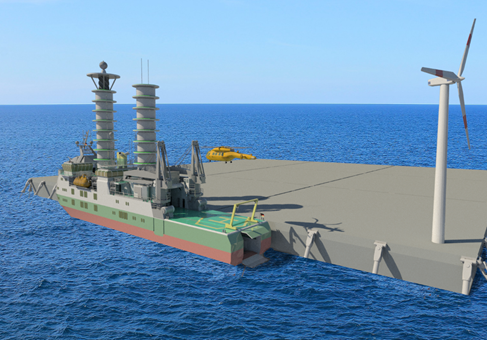Milestone reached: The basic floater design is completed
One of the key element in the first year of the Space@Sea is the basic design of the floaters building up the flexible floating island. The starting point of the project was a triangular shape of the floater because connected triangles move more flexible with respect to each other. From a practical point of view, triangles are not optimal. Because of this, Space@Sea reviewed other shapes and sizes of the floater in the concept design. This resulted in the decision to use rectangular floaters with a side length of 45 metres for the small floater and 90 metres for the large floater.
Designing the optimised standard module is one of the objectives of the fourth work package. The shape and size of this module are at the heart of the Space@Sea project. Lead by MARIN, the Space@Sea partners have worked on this design since the project started in November 2017. The target is to work with one shape with two principle dimensions which fit together. Four considerations were distinguished:
- Module size
- Module shape
- Module principle
- Mooring and connection
From practical point of view, a square module is preferred over a triangle, rectangular or hexagonal shape. Simulations with the MARIN aNySIM tool were carried out to assess the quantitative differences between connection forces of islands build up of triangular or square modules. Simulations were done in sea states with unit significant wave height and a range of peak periods and headings. From this work it was concluded that maximum connection forces for the two island configuration are similar. The work also showed that large forces occur more frequent for the island consisting of square modules. At present this is, however, no reason to choose the triangle over the square.
A small module size is beneficial with respect to the flexibility it provides for the island formations. From a transport and installation perspective, however, the larger module sizes are easier to handle and at lower costs. Also from functional point of view a larger module is preferred. Weighing all the aspects has lead to a module size of 45m. As additional size a 90m module is considered.
A barge type structure is well in line with what is currently build and the most straightforward building solution. Other principles were investigated but certainly do not outweigh the barge advantages. The different applications envisioned within the Space@Sea all have their own weight requirements. Piling the modules is then a solution that allows for standardized modules while still coping with the different draughts resulting from the envisioned applications. For the standard height of the module 4m is used, having its mooring at dedicated modules is the preferred solution.

Next step in the process is to make the final design. This will among others address the possibility of achieving an appropriate connection stiffness, the choice for building material and the details of the mooring system.

